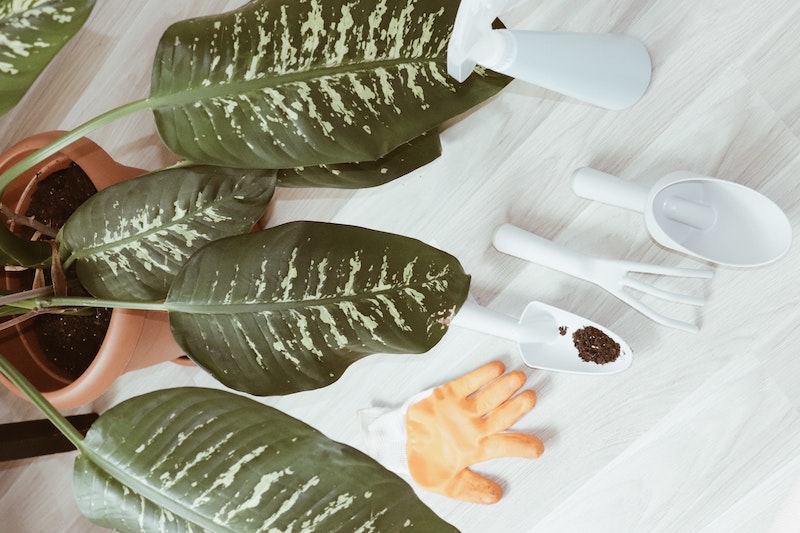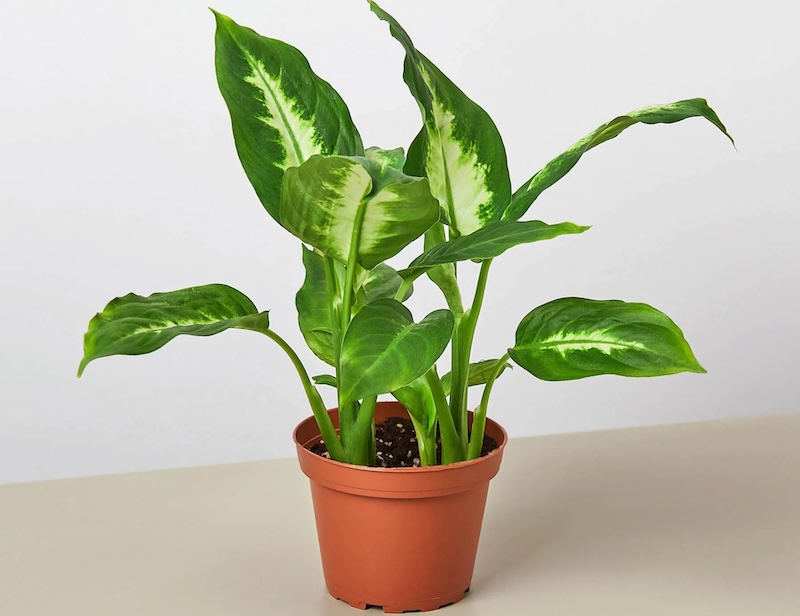Growing Dieffenbachia
Few other houseplants offer the tropical interest combined with low-maintenance requirements of the dieffenbachia. Dieffenbachia, also known as dumb cane, is a genus of tropical perennials with several species widely available as houseplants. Vigorous growers, these plants can reach a height of 10 feet, although when kept indoors they generally stay within the 3 to 5 foot range. Native to Central and South America, dieffenbachias are also prized for their air-purifying properties. This houseplant is suitable for beginner growers.

Dieffenbachia Sunlight Requirements
Dieffenbachia performs best in bright indirect light. Direct sunlight can cause leaves to lose their attractive color and burn. The ideal location indoors might involve positioning the plant near a window but avoiding direct light. A dieffenbachia can tolerate lower light levels, but growth will slow. Low light will also cause spindly, stretched growth. In winter when the sun is less intense, it will tolerate a longer period of direct light. Make sure to regularly rotate the plant, as it has a tendency to grow strongly towards the light.
Planting Dieffenbachia
Choose a growing container that offers plenty of drainage holes. Use a well-drained potting soil to avoid leaving the plant’s roots sitting in soggy conditions. A fast grower, dieffenbachia may require repotting every one to two years. Indicators that a plant may be ready for repotting include roots emerging above the soil surface, frequent wilting from water stress, crowding, and leaf loss. Time the repotting for early spring when the plant is actively growing. Choose a new container that is only slightly larger than the existing container and check the moisture level of the soil more frequently until new growth emerges. Over time, the plant may become tall and leggy. Address this with regular cutting back of up to one-third of the plant height.

Watering Dieffenbachia
Water the plant deeply whenever the top 2 inches of potting soil feel dry to the touch. Use distilled water or rainwater. Watering requirements may drop drastically in the winter months when the dieffenbachia growth rate slows. This houseplant does fine with average humidity, but like many tropical specimens, it prefers high humidity levels. In particularly dry winter months, keeping the plant on a pebble tray or regularly misting will keep the plant looking healthy and attractive.
Fertilizing Dieffenbachia
Regular feeding promotes vigorous growth and healthy, attractive foliage. Fertilize dieffenbachia monthly when the plant is actively growing in spring and summer. Use a water-soluble, balanced fertilizer diluted to half strength. Choose a plant food with an NPK ratio such as 10-10-10 or one labeled for foliar houseplants and follow label instructions for mixing and applying. Never apply fertilizer to a plant that is drought stressed. Instead, water the plant thoroughly and then fertilize it a day or two later. Applying fertilizer to dry plants can burn the sensitive roots. Halt fertilizer applications in the cooler months when plant growth slows.

Common Dieffenbachia Problems
The tips and leaf margins of dieffenbachia may turn brown and the entire leaf may then yellow if you water it with softened or tap water. Dieffenbachia are not particularly prone to pests or diseases, but may occasionally be bothered by spider mites or scale insects. Inspect plants regularly and wipe leaves down with a damp cloth to minimize the dry, dusty conditions that mites prefer. Overwatering or poor drainage, especially in conjunction with cool temperatures, can lead to root and stem rot. If the environment is too cool, the dieffenbachia has a tendency to lose its lower leaves. Lower leaves normally turn brown as they age. Remove these as they appear.
Propagating Dieffenbachia
The easiest way to multiply dieffenbachia is by rooting stem or tip cuttings. Prepare a shallow pot with a media formulated for rooting or germination, or use a mixture of sand and peat moss. Cleanly cut off a few inches of a growing tip, dip the cut end in rooting hormone (if available), and stick the end in the prepared rooting medium. For stem cuttings, take 2-inch or slightly longer segments of stem and lay them horizontally on the medium. Keep either type of cutting evenly moist until roots and new growth emerge. It is also possible to divide a dieffenbachia; this is best done in spring during repotting. Gently separate or cleanly cut the root mass into two or more sections with proportionate amounts of root and stem.
Growing Dieffenbachia Outdoors
Dieffenbachia in containers can be brought outside in warm weather to add some tropical flair to a backyard or patio, provided the plant can stay in mostly shaded conditions. The ideal temperature range for dieffenbachia is 65 to 75 degrees Fahrenheit. Temperatures below 60 degrees can lead to leaf loss, so avoid bringing the plant outdoors until temperatures are reliably above this level. Allow the dieffenbachia to slowly acclimate to outdoor conditions slowly over a week or so. Plants kept outdoors may require more frequent watering than those growing indoors, so check the soil regularly. Inspect the dieffenbachia thoroughly for pests before bringing it back indoors in the fall.
 |
Author Angela Ryczkowski - Published 2-25-2023 |
